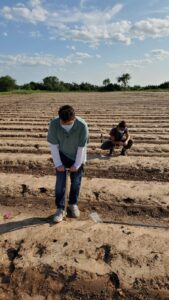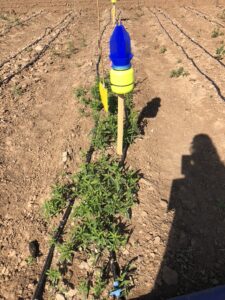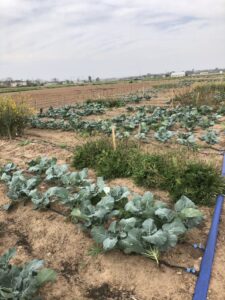Final report for OS20-139
Project Information
Farm edges are generally the most undisturbed areas in a farm with diverse vegetation and can enhance agrobiodiversity and provide crucial food and shelter for wildlife, insects, and soil biota. Planting native wildflowers with the ability to reseed and withstand local climatic conditions for semi-permanent vegetation around farm edges or in between crops has potential to biologically control pests. To test this, we ran a two-year study and installed three different flowering insectary strips on a certified organic vegetable farm in South Texas during the winter season. The treatments were: 1) a commercially sourced 17-species native wildflower seed mix; 2) sunn hemp (Crotalaria juncea); and 3) weeds that spontaneously germinated. We collected pitfall traps, sticky traps, and blue-vein pollinator trap to capture above ground arthropods and ran PFLAs to determine the proportions of soil microbes. Our results show that the soil microbial communities were influenced by treatment, location, and time. The middle of the insectary strips had significantly higher fungal to bacterial ratios and gram-negative proportions compared to the cash crops. Arthropod communities were influence by time and location but not treatment. Traps collected later in the season showed fewer pests (main order Hemiptera) and more beneficials (main orders Coleoptera and Hymenoptera) in the middle of the insectary strip compared to the cash crop.
Experimental Design
We established a randomized block experimental design to test the multiple benefits of insectary strips at a certified organic vegetable farm in Edinburg, Texas. Soil was cross-disked and bedded to terminate the weeds and conserve soil moisture, both of which are standard practices for farmers in South Texas. The planting beds were 1.5 meters wide from one center of a bed to the next. There was an insectary strips between every four beds of cash crop. The topsoil was raked 2.5 cm deep. Sunn hemp and native seeds were broadcasted by hand and covered to ensure soil to seed contact. A 3-meter buffer was continuously weeded to separate one treatment side from the other. For the first year, insectary strips were planted on October 2, 2020, and the cash crop seedlings were transplanted on December 10, 2020, in two rows, 45 cm apart, in a staggered manner for a total of five plants per bed. In year two, the insectary strips were planted on Aug. 15, 2021, and the cash crop seedlings were transplanted on Oct 5, 2021, in two rows, 30 cm apart, for 10 plants per bed.
Data collection: Insects
To examine the arthropod community dynamics, three types of traps were employed to collect arthropod community structure data present in the region. We used odorless sticky traps (Pherocon® AM Yellow; Trece, Inc., Adair, OK, USA) and pitfall traps filled ¼ths with water and a couple of drops of odorless soap (Micro-90 odorless detergent (Cole-Parmer, catalog number: SK-18100-05) to break the surface tension of the water. These two traps were placed in the middle of the insectary strips, the edge of the insectary strips, and the middle of the cash crop row, approximately 3 meters from the insectary strip. Blue Vane pollinator traps (BanfieldBioTM Inc., Seattle, WA) with yellow collection jars were only placed in the middle of the insectary strips
Data collection: Soil
Soil samples were collected at two different times, two weeks after cash crops were transplant (early) and at-harvest (late). In year one, samples were collected on December 15, 2020 (early), and March 8, 2021 (late). In year two, samples were collected on December 15, 2021 (early), and February 5, 2022 (late). A total of three subsamples were collected from each plot with a soil corer with a 2.5 cm diameter (AMS, American Falls, ID) to a depth of 0-20 cm with even spacing between each core, avoiding drip line and plant roots. Probe, spatula, and gloves were cleaned with water then 80% ethanol (Fisher Scientific Waltham, MA, USA) in between each treatment block. The mixed composite samples were transferred to a 50 mL centrifuge tube and placed in a -80 °C freezer until shipped on dry ice to the lab for analysis. Note, year one samples were analyzed at the San Joaquin Valley Agriculture Sciences Center (Parlier, California, USDA-ARS) and year two samples were analyzed at WARD Laboratory (Kearney, Nebraska, USA).
Cash crops
To determine impact on cash crop and plant fitness, we collected fruit weight for 10 plants per treatment block (n = 180), took the weight of each broccoli head in year one and the weight of the total number of peppers per plant. To determine pest-induced damaged, five broccoli plants were rated on a scale of 0 to 5 (least to worst) and percentage of damaged pepper for each plant was calculated.
Cooperators
- (Researcher)
- - Producer
Research
We established a randomized block experimental design to test the multiple benefits of insectary strips at a certified organic vegetable farm, in Edinburg, Texas. On October 2, 2020, 3 feet wide insectary strips were created between every 4 rows of cash crop that were made 5 feet wide from center to center. We transplanted 2 rows of broccoli 18” apart in a staggered manner on December 10, 2020. A total of 3 treatments of insectary strips were replicated 6 times on the 3,2670 square foot research plot. This three insectary strip treatments include:
- Native wildflower mix, 19 species
- Sunn hemp, a nonnative hedge row species commonly used
- Control, no management
Sunn hemp seeds were purchased from Johnny’s Selected Seeds Co. and the native wildflower cocktail was purchased from Douglas King Seeds in San Antonio, Texas. The seed mix, ‘Feed the Bees Pollinator Mix’, contains 18 species: Texas Bluebonnet, Cuero Purple Prairie Clover, Eldorado Engelmann Daisy, South Texas Gaillardia, Venado Awnless Bush Sunflower, Zapata Rio Grande Clammyweed, Partridge Peas, Plains Coreopsis, Purple Coneflower, Clasping Leaf Coneflower, Black-Eyed Susan, Mexican Hat, Lanceleaf Coreopsis, Lemon Mint, Standing Cypress, Drummond Phlox.
Sunn hemp was planted at a recommended rate of 28 grams per square meter, and the native seed mix was planted at 10 grams per square meter. Both Sunn hemp and the native wildflower mix were broadcasted by hand October 2nd, 2020. Seeds were slightly covered with soil and padded down with a garden hoe. Drip irrigation was applied once a week for 4 hours during the study period. Sunn hemp will be replanted in June or July before planting onion for the next round of cash crop. These strips will be maintained during the summer and again in the fall of 2021.
Insect community dynamics
To determine if the native wildflower mix attracts more biodiversity compared to Sunn hemp and control, I collected insect samples 4 different times: before cash crop planting, during cash crop establishment, before cash crop harvest, and after cash crop harvest. I set up sticky traps and pitfall traps in three different locations: in the middle of the second cash crop row to the north of the insectary strips, on the edge of the insectary strips, and in the middle of the insectary strips (n=54) (Figure 3). Pollinator traps were installed at the middle of each insectary strips (n=18). The pitfall trap was prepared in 250 ml clear plastic cups filled with 60 ml of water and micro-90 solution. The pollinator traps were also filled with the water micro-90 solution. The insect samples in all traps were collected after 48 hours and transported to the lab for analysis. The sticky traps were stored in the freezer, and the pitfall and pollinator traps were cleaned on a 120-mesh sieve immediately after collection and transferred in test tubes with 70% ethanol. Insects collected from these traps will be grouped as herbivores, predators, parasitoids, and pollinators and analyzed to determine the insect diversity, species richness, species evenness, and beneficial to pest ratio across the three treatments. Insect trap layout and timing will again be repeated in the fall of 2021.
Cash crop yield and pest damage
Ninety days after planting, when the broccoli heads were ready to harvest, 5 random broccoli plants per treatment were photographed to evaluate pest damage. Each leaf on the plant was turned over to inspect for insects. Each plant was rated on a scale of 0-5; 0 meaning no insect damage and 5 indicating severe damage. Insects on the leaves, when visible, were photographed for record. On the same day, yield measurements were taken for 10 randomly selected plants. The broccoli plants suffered mainly from frost bite from the freeze.
Soil health
In the fall of 2020, we collected 6 soil cores to make one composite sample, each 0-20 cm deep, from each subplot in the same locations where the insect samples were collected. We maintained even spacing between each of these cores and were considerate of the distances of these cores from vine or plant trunks and irrigation lines. Holes were refilled to prevent a “swizz cheese” effect. Tools and gloves were disinfected with 90% isopropyl alcohol using a clean paper towel between each plot. Cores were mixed to make a composite sample by touching the outside of the bag and shaking well. A portion of soil samples were then transferred to 50 mL centrifuge tubes that were sealed and placed into a cooler with ice and transported to the lab. The soil samples in the 50ml tubes were divided into 2 subsamples, ~30 g for PFLA and ~20 g for DNA extraction and stored in a freezer until analysis. Soil samples for PLFA were placed on dry ice and shipped overnight to the Water Management Research Unit. For the soil microbial community analysis, we currently extracting the DNA from 72 samples (samples from planting and harvest times) using the MP Fast DNA Spin Kit. These DNA samples will then be sent to the UT Austin DNA Sequencing Facility for the 16s sequencing. This will again be repeated for Fall 2021 planting season. Additionally, during the fall season, we will collect root samples in both the cash crop and insectary strips to determine the total mycorrhizal colonization in the roots, nematode community, and the prevalence of plant parasitic nematodes. We will measure soil respiration biweekly with a 6400-09 Soil CO2 Flux Chamber.
Our preliminary results show that the soil microbial community were influenced by treatment, location, and time. The native wildflowers significantly increased the fungal to bacterial ratios compared sunn hemp. Time influenced fungal to bacterial ratios, gram-positive to gram-negative bacteria ratios, arbuscular mycorrhizae fungi proportions, carbon to nitrogen ratios, and organic matter. Finally, the middle of the insectary strips had a higher fungal to bacterial ratios and gram-negative proportions compared to the cash crops.
A total of 21,397 insects were identified and categorized by order, function, and feeding guilds. We found no differences in cash crop yield amongst the treatments in either year. However, arthropod communities were influenced by time and location. We found the more beneficials and fewer pests in the middle of the insectary strips compared to the cash crop.
Educational & Outreach Activities
Participation summary:
Justin Lerma, an undergraduate student participating in this project did a poster presentation at the Engaged Scholar Award Symposium at UTRGV.
This project served as MS thesis research for graduate student, Ms. Lindsey Richards. Lindsey presented her work at the following meetings/confrences:
- Subtropical Agriculture and Environment Annual Meeting
- Texas Organic Farmers and Gardeners Association Annual Meeting
- Soil Ecology Society 2022 Biennial Meeting
- UTRGV College of Science Annual Research Conference
Learning Outcomes
Project Outcomes
Through our project we were able to demonstrate that using native flowering plants for windbreaks between fields and along weedy margins have multiple benefits. Our study was impacted by the unusual severe weather conditions in south Texas. Even under unfavorable conditions, our results show that:
- native plants can tolerate and survive unfavorable conditions while the most commonly used nonnative plant couldn't.
- using native flowering plants along farm margins provides resources and promote insect diversity.
- having a dense growth of native plants along farm margins can reduce the growth of invasive weeds.
- native plants attract high number of predators and can potentially reduce the pest pressure.
This was short term study. Based on the number of researchers who have reached out to us inquiring about this topic we can say it has generated a lot of interest or is a topic of interest for not only organic farmers but for researchers and land managers interested in promoting native plants.
It takes time to see the benefits of such projects, thus funding long term project would be much useful.



